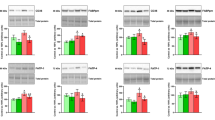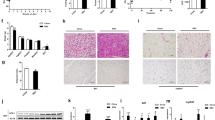Abstract
Objective:
Besides their role in lipid absorption, bile acids (BAs) can act as signalling molecules. Cholic acid was shown to counteract obesity and associated metabolic disorders in high-fat-diet (cHF)-fed mice while enhancing energy expenditure through induction of mitochondrial uncoupling protein 1 (UCP1) and activation of non-shivering thermogenesis in brown adipose tissue (BAT). In this study, the effects of another natural BA, chenodeoxycholic acid (CDCA), on dietary obesity, UCP1 in both interscapular BAT and in white adipose tissue (brite cells in WAT), were characterized in dietary-obese mice.
Research design:
To induce obesity and associated metabolic disorders, male 2-month-old C57BL/6J mice were fed cHF (35% lipid wt wt−1, mainly corn oil) for 4 months. Mice were then fed either (i) for 8 weeks with cHF or with cHF with two different doses (0.5%, 1%; wt wt−1) of CDCA (8-week reversion); or (ii) for 3 weeks with cHF or with cHF with 1% CDCA, or pair-fed (PF) to match calorie intake of the CDCA mice fed ad libitum; mice on standard chow diet were also used (3-week reversion).
Results:
In the 8-week reversion, the CDCA intervention resulted in a dose-dependent reduction of obesity, dyslipidaemia and glucose intolerance, which could be largely explained by a transient decrease in food intake. The 3-week reversion revealed mild CDCA-dependent and food intake-independent induction of UCP1-mediated thermogenesis in interscapular BAT, negligible increase of UCP1 in subcutaneous WAT and a shift from carbohydrate to lipid oxidation.
Conclusions:
CDCA could reverse obesity in cHF-fed mice, mainly in response to the reduction in food intake, an effect probably occuring but neglected in previous studies using cholic acid. Nevertheless, CDCA-dependent and food intake-independent induction of UCP1 in BAT (but not in WAT) could contribute to the reduction in adiposity and to the stabilization of the lean phenotype.
This is a preview of subscription content, access via your institution
Access options
Subscribe to this journal
Receive 12 print issues and online access
$259.00 per year
only $21.58 per issue
Buy this article
- Purchase on Springer Link
- Instant access to full article PDF
Prices may be subject to local taxes which are calculated during checkout




Similar content being viewed by others
References
Angelin B, Einarsson K, Hellstrom K, Leijd B . Effects of cholestyramine and chenodeoxycholic acid on the metabolism of endogenous triglyceride in hyperlipoproteinemia. J Lipid Res 1978; 19: 1017–1024.
Teodoro JS, Rolo AP, Palmeira CM . Hepatic FXR: key regulator of whole-body energy metabolism. Trends Endocrinol Metab 2011; 22: 458–466.
Watanabe M, Houten SM, Wang L, Moschetta A, Mangelsdorf DJ, Heyman RA et al. Bile acids lower triglyceride levels via a pathway involving FXR, SHP, and SREBP-1c. J Clin Invest 2004; 113: 1408–1418.
Kast HR, Nguyen CM, Sinal CJ, Jones SA, Laffitte BA, Reue K et al. Farnesoid X-activated receptor induces apolipoprotein C-II transcription: a molecular mechanism linking plasma triglyceride levels to bile acids. Mol Endocrinol 2001; 15: 1720–1728.
Sinal CJ, Tohkin M, Miyata M, Ward JM, Lambert G, Gonzalez FJ . Targeted disruption of the nuclear receptor FXR/BAR impairs bile acid and lipid homeostasis. Cell 2000; 102: 731–744.
Stayrook KR, Bramlett KS, Savkur RS, Ficorilli J, Cook T, Christe ME et al. Regulation of carbohydrate metabolism by the farnesoid X receptor. Endocrinology 2005; 146: 984–991.
Cariou B, van Harmelen K, Duran-Sandoval D, van Dijk TH, Grefhorst A, Abdelkarim M et al. The farnesoid X receptor modulates adiposity and peripheral insulin sensitivity in mice. J Biol Chem 2006; 281: 11039–11049.
Duran-Sandoval D, Cariou B, Percevault F, Hennuyer N, Grefhorst A, van Dijk TH et al. The farnesoid X receptor modulates hepatic carbohydrate metabolism during the fasting-refeeding transition. J Biol Chem 2005; 280: 29971–29979.
Abdelkarim M, Caron S, Duhem C, Prawitt J, Dumont J, Lucas A et al. The farnesoid X receptor regulates adipocyte differentiation and function by promoting peroxisome proliferator-activated receptor-gamma and interfering with the Wnt/beta-catenin pathways. J Biol Chem 2010; 285: 36759–36767.
Watanabe M, Morimoto K, Houten SM, Kaneko-Iwasaki N, Sugizaki T, Horai Y et al. Bile acid binding resin improves metabolic control through the induction of energy expenditure. PloS One 2012; 7: e38286.
Konikoff FM . Gallstones - approach to medical management. MedGenMed 2003; 5: 8.
Prawitt J, Caron S, Staels B . Bile acid metabolism and the pathogenesis of type 2 diabetes. Curr Diab Rep 2011; 11: 160–166.
Katona BW, Cummins CL, Ferguson AD, Li T, Schmidt DR, Mangelsdorf DJ et al. Synthesis, characterization, and receptor interaction profiles of enantiomeric bile acids. J Med Chem 2007; 50: 6048–6058.
Neuschwander-Tetri BA . Farnesoid x receptor agonists: what they are and how they might be used in treating liver disease. Curr Gastroenterol Rep 2012; 14: 55–62.
Watanabe M, Houten SM, Mataki C, Christoffolete MA, Kim BW, Sato H et al. Bile acids induce energy expenditure by promoting intracellular thyroid hormone activation. Nature 2006; 439: 484–489.
Cannon B, Nedergaard J . Brown adipose tissue: function and physiological significance. Physiol Rev 2004; 84: 277–359.
Wu J, Cohen P, Spiegelman BM . Adaptive thermogenesis in adipocytes: is beige the new brown? Genes Dev 2013; 27: 234–250.
Rothwell NJ, Stock MJ . A role for brown adipose tissue in diet-induced thermogenesis. Nature 1979; 281: 31–35.
da-Silva WS, Ribich S, Arrojo e Drigo R, Castillo M, Patti ME, Bianco AC . The chemical chaperones tauroursodeoxycholic and 4-phenylbutyric acid accelerate thyroid hormone activation and energy expenditure. FEBS Lett 2011; 585: 539–544.
Watanabe M, Horai Y, Houten SM, Morimoto K, Sugizaki T, Arita E et al. Lowering bile acid pool size with a synthetic farnesoid X receptor (FXR) agonist induces obesity and diabetes through reduced energy expenditure. J Biol Chem 2011; 286: 26913–26920.
Zingaretti MC, Crosta F, Vitali A, Guerrieri M, Frontini A, Cannon B et al. The presence of UCP1 demonstrates that metabolically active adipose tissue in the neck of adult humans truly represents brown adipose tissue. FASEB J 2009; 23: 3113–3120.
Young P, Arch JR, Ashwell M . Brown adipose tissue in the parametrial fat pad of the mouse. FEBS Lett 1984; 167: 10–14.
Loncar D . Convertible adipose tissue in mice. Cell Tissue Res 1991; 266: 149–161.
Cousin B, Cinti S, Morroni M, Raimbault S, Ricquier D, Penicaud L et al. Occurrence of brown adipocytes in rat white adipose tissue: molecular and morphological characterization. J Cell Sci 1992; 103: 931–942.
Petrovic N, Walden TB, Shabalina IG, Timmons JA, Cannon B, Nedergaard J . Chronic peroxisome proliferator-activated receptor gamma (PPARgamma) activation of epididymally derived white adipocyte cultures reveals a population of thermogenically competent, UCP1-containing adipocytes molecularly distinct from classic brown adipocytes. J Biol Chem 2010; 285: 7153–7164.
Frontini A, Vitali A, Perugini J, Murano I, Romiti C, Ricquier D et al. White-to-brown transdifferentiation of omental adipocytes in patients affected by pheochromocytoma. Biochim Biophys Acta 2013; 1831: 950–959.
Jespersen NZ, Larsen TJ, Peijs L, Daugaard S, Homoe P, Loft A et al. A classical brown adipose tissue mRNA signature partly overlaps with brite in the supraclavicular region of adult humans. Cell Metab 2013; 17: 798–805.
Nedergaard J, Cannon B . UCP1 mRNA does not produce heat. Biochim Biophys Acta 2013; 1831: 943–949.
Kuda O, Jelenik T, Jilkova Z, Flachs P, Rossmeisl M, Hensler M et al. n-3 fatty acids and rosiglitazone improve insulin sensitivity through additive stimulatory effects on muscle glycogen synthesis in mice fed a high-fat diet. Diabetologia 2009; 52: 941–951.
Medrikova D, Jilkova ZM, Bardova K, Janovska P, Rossmeisl M, Kopecky J . Sex differences during the course of diet-induced obesity in mice: adipose tissue expandability and glycemic control. Int J Obes 2012; 36: 262–272.
Rossmeisl M, Jelenik T, Jilkova Z, Slamova K, Kus V, Hensler M et al. Prevention and reversal of obesity and glucose intolerance in mice by DHA derivatives. Obesity 2009; 17: 1023–1031.
Salmon DM, Flatt JP . Effect of dietary fat content on the incidence of obesity among ad libitum fed mice. Int J Obes 1985; 9: 443–449.
Kopecky J, Rossmeisl M, Hodny Z, Syrovy I, Horakova M, Kolarova P . Reduction of dietary obesity in aP2-Ucp transgenic mice: mechanism and adipose tissue morphology. Am J Physiol 1996; 270: E776–E786.
Smith PK, Krohn RI, Hermanson GT, Mallia AK, Gartner FH, Provenzano MD et al. Measurement of protein using bicinchoninic acid. Anal Biochem 1985; 150: 76–85.
Kus V, Prazak T, Brauner P, Hensler M, Kuda O, Flachs P et al. Induction of muscle thermogenesis by high-fat diet in mice: association with obesity-resistance. Am J Physiol Endocrinol Metab 2008; 295: E356–E367.
Flachs P, Ruhl R, Hensler M, Janovska P, Zouhar P, Kus V et al. Synergistic induction of lipid catabolism and anti-inflammatory lipids in white fat of dietary obese mice in response to calorie restriction and n-3 fatty acids. Diabetologia 2011; 54: 2626–2638.
Weir JB . New methods for calculating metabolic rate with special reference to protein metabolism. J Physiol 1949; 109: 1–9.
Even PC, Nadkarni NA . Indirect calorimetry in laboratory mice and rats: principles, practical considerations, interpretation and perspectives. Am J Physiol Regul Integr Comp Physiol 2012; 303: R459–R476.
Seale P, Conroe HM, Estall J, Kajimura S, Frontini A, Ishibashi J et al. Prdm16 determines the thermogenic program of subcutaneous white adipose tissue in mice. J Clin Invest 2011; 121: 96–105.
Butler AA, Kozak LP . A recurring problem with the analysis of energy expenditure in genetic models expressing lean and obese phenotypes. Diabetes 2010; 59: 323–329.
Himms-Hagen J . On raising energy expenditure in ob/ob mice. Science 1997; 276: 1132–1133.
Kaiyala KJ, Schwartz MW . Toward a more complete (and less controversial) understanding of energy expenditure and its role in obesity pathogenesis. Diabetes 2011; 60: 17–23.
Greiner T, Backhed F . Effects of the gut microbiota on obesity and glucose homeostasis. Trends Endocrinol Metab 2011; 22: 117–123.
Acknowledgements
JST, FVD, APG and ATV were recipients of a Fundação para a Ciência e a Tecnologia PhD scholarship (SFRH/BD/38467/2007, SFRH/BD/38372/2007, SFRH/BD/44674/2008 and SFRH/BD/44796/2008, respectively). This project was supported by a FCT grant PTCD/SAU-OSM/72443/2006, PEst-C/SAU/LA0001/2011 and EU FP7 project DIABAT (HEALTH-F2—2011-278373) and by the Czech Science Foundation (13-00871S).
Author information
Authors and Affiliations
Corresponding author
Ethics declarations
Competing interests
The authors declare no conflict of interest.
Additional information
Supplementary Information accompanies this paper on International Journal of Obesity website
Supplementary information
Rights and permissions
About this article
Cite this article
Teodoro, J., Zouhar, P., Flachs, P. et al. Enhancement of brown fat thermogenesis using chenodeoxycholic acid in mice. Int J Obes 38, 1027–1034 (2014). https://doi.org/10.1038/ijo.2013.230
Received:
Revised:
Accepted:
Published:
Issue Date:
DOI: https://doi.org/10.1038/ijo.2013.230
Keywords
This article is cited by
-
Pharmacological modulation of adaptive thermogenesis: new clues for obesity management?
Journal of Endocrinological Investigation (2023)
-
Metabolic Messengers: bile acids
Nature Metabolism (2022)
-
Bile acid supplementation decreases body mass gain in C57BL/6J but not 129S6/SvEvTac mice without increasing energy expenditure
Scientific Reports (2019)
-
Brown Adipose Tissue: an Update on Recent Findings
Current Obesity Reports (2017)



